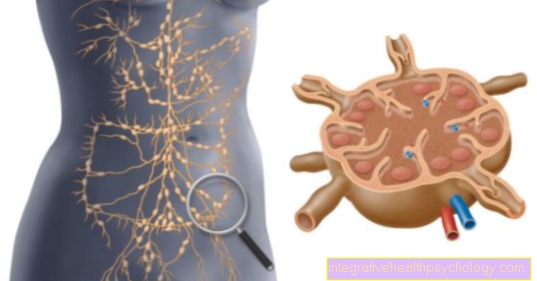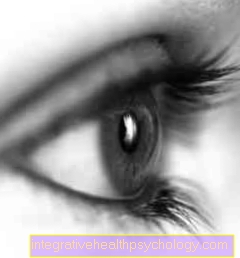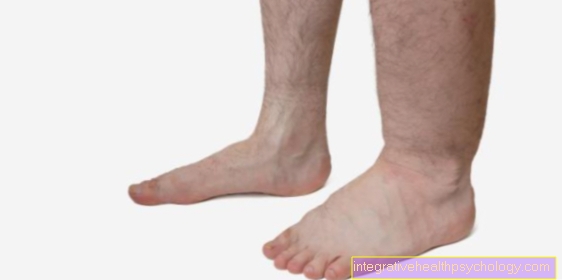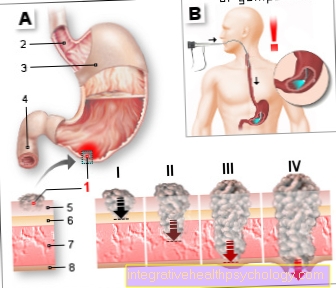Cataract symptoms
Cataract symptoms

The main symptom of the most common type of cataract acquired (old age cataract) is a deterioration in vision that develops over the years and therefore only becomes noticeable from a certain stage.
The environment appears more and more colorless, contrasts lose their sharpness. Those affected often complain of blurred vision symptoms.
In bright light (for example the headlights of oncoming cars in the dark), the diffuse refraction of the rays causes severe glare. So-called halos are created around light sources (e.g. lamps).
Double vision is also described as an occasional symptom. The clouding also causes a change, more precisely an increase in the refractive power of the lens, so that an existing presbyopia can sometimes be compensated for and such patients no longer need reading glasses for the time being.
Presbyopia (Presbyopia) is caused by the loss of elasticity of the lens and the resulting reduced ability to focus the eye on objects at a short distance. This positive effect on presbyopia only exists for a short time. In the advanced stage, the clouding of the lens is also noticeable externally. It is also interesting that these people no longer get “red eyes” in photos taken with a flash.
With the other acquired cataracts (see classification), the deterioration in vision often develops much faster. Accordingly, the changes and typical symptoms are also more likely to be perceived.
In the congenital forms, the cataract is of course already there and does not have to develop slowly. In most cases, an immediate operation is important here, as otherwise the development of vision may be disturbed and there is often a risk of serious visual impairment and even blindness.
Recognize a cataract
Cataract is an age-related eye disease in which the lens becomes cloudy. This also causes the associated symptoms. The focus is on a deterioration in vision, in which the sharpness of vision is increasingly impaired. Objects can then no longer be properly focused and merge with their surroundings, since colors and contrasts are also becoming increasingly difficult to perceive.
Patients with cataracts often report a type of haze that limits their field of vision. As the disease progresses, this becomes larger and denser and, if left untreated, can lead to complete blindness.
An increased sensitivity to light can also appear as a symptom of cataracts.
The first symptoms are often noticed when driving a car in poor visibility conditions or at night, as the visibility is already reduced in these situations.
Those affected, however, often play down these symptoms and attribute them to other causes, such as tiredness or a generally worsened general condition. However, it is important for the further course of the disease to understand these symptoms as an expression of an eye disease and to present yourself to an ophthalmologist as quickly as possible.
Headache as a typical symptom of cataracts
Those affected often complain of headaches. These can be explained by the fact that vision is restricted and the recognition of objects is associated with greater effort. When trying to focus on something, those affected often frown and tense the facial muscles more. This ultimately leads to eye fatigue and headaches.
The increased sensitivity to light and glare can also cause headaches with increased light exposure, as the eyes are narrowed reflexively to let less light into the eye.
Figure cataract

Cataract (cataract)
A - clear lens
(healthy eye)
B - clouded lens
(Cataract eye)
- Cornea - Cornea
- pupil
- Iris - iris
- Eye lens - Lens
- Vitreous - Corpus vitreum
- Retina - retina
- Optic nerve (2nd cranial nerve) -
Optic nerve - Punk-shaped, sharp figure
on the retina - Scattered light on the retina out of focus
You can find an overview of all Dr-Gumpert images at: medical illustrations
Related topics
More information on cataracts:
- Main subject of cataracts
- Lens Opacity, Cataracts - You Should Know That!
- Cataracts: causes
- Cataracts: surgery
- Cataracts: treatment
Further information that may be of interest to you:
- Green Star
- Ophthalmology
- eye
- diopter
A list of all the topics related to ophthalmology that we have already published can be found at:
- Ophthalmology A-Z





























